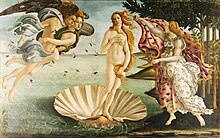This is the current revision of this page, as edited by Cinder painter (talk | contribs) at 08:02, 13 January 2025 (AFC draft). The present address (URL) is a permanent link to this version.
Revision as of 08:02, 13 January 2025 by Cinder painter (talk | contribs) (AFC draft)(diff) ← Previous revision | Latest revision (diff) | Newer revision → (diff)Find sources: Google (books · news · scholar · free images · WP refs) · FENS · JSTOR · TWL Last edited by Cinder painter (talk | contribs) 23 hours ago. (Update) Finished drafting? Submit for review or Publish now |
This article has multiple issues. Please help improve it or discuss these issues on the talk page. (Learn how and when to remove these messages)
|
Sea foam art is an artistic genre that captures the ephemeral beauty of sea foam, symbolizing the transient nature of life and the dynamic interplay between land and sea. This subject has been explored across various cultures and artistic movements, inspiring a range of interpretations and techniques.
Historical depictions

In ancient Greek mythology, sea foam is notably associated with the birth of Aphrodite, the goddess of love, who is said to have emerged from the sea's froth. This myth has inspired numerous artworks, including Sandro Botticelli's renowned painting "The Birth of Venus," which portrays the goddess standing on a shell, being blown towards the shore by the wind gods.
Japanese art
Japanese art has a rich tradition of depicting natural elements, including the sea and its movements. Artists like Ogata Kōrin, known for his work "Rough Waves," have captured the dynamic essence of ocean waves and foam, reflecting the cultural appreciation for nature's beauty and power.
Cultural significance
Sea foam often symbolizes beauty emerging from chaos, as seen in mythological artworks like the birth of Venus. In Japanese culture, the depiction of sea foam in art can reflect themes of impermanence and the transient nature of life, aligning with the aesthetic principle of "mono no aware."
Impressionist interpretations
The Impressionist movement brought a renewed focus on natural light and movement, with artists like Joaquín Sorolla y Bastida capturing the interplay of light on water and foam. His painting "Boy in Sea Foam" exemplifies this approach, depicting a child wading through foamy waters with a vibrant, light-infused palette.
Artistic techniques
Depicting sea foam presents unique challenges due to its intricate patterns and transient nature. Artists employ various techniques to capture its essence, such as using contrasting brushstrokes, layering, and glazing to convey the texture and movement of foam within seascapes. Acrylic painting tutorials, for example, guide artists in capturing the texture and movement of sea foam in seascapes.
Notable works

- The Birth of Venus by Sandro Botticelli: This iconic painting depicts the goddess Venus emerging from the sea on a shell, with sea foam symbolizing her divine origin.
- Rough Waves by Ogata Kōrin: A Japanese artwork capturing the dynamic and powerful movement of ocean waves and foam.
- Boy in Sea Foam by Joaquín Sorolla: An Impressionist painting portraying a child wading through foamy waters, highlighting the interplay of light and movement.
See also
- Sea foam: A type of foam created by the agitation of seawater
- Marine art: A genre of art that portrays or draws inspiration from the sea
- Seascape: Artistic representations of the sea.
- List of art techniques: A compilation of various methods used in creating art
References
- "Boy in Sea Foam, 1900 - Joaquín Sorolla - WikiArt.org". www.wikiart.org. Retrieved 2025-01-13.
Category: